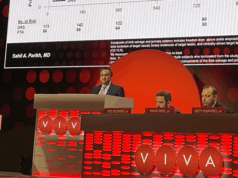
The first report of six-month results from the SUCCESS PTA trial evaluating the Selution SLR (Cordis) drug-eluting balloon has shown that consistent haemodynamic, functional and clinical improvements were observed, associated with a 97.7% freedom from clinically-driven target lesion revascularisation (CD-TLR), which was reported as 97% for the chronic limb-threatening ischaemia (CLTI) subgroup.
Presenter Michael Lichtenberg (Vascular Center Clinic, Arnsberg, Germany) shared these data during the FIRST@CIRSE session at the Cardiovascular and Interventional Radiological Society of Europe (CIRSE) annual congress (14–18 September, Lisbon, Portugal).
The SUCCESS PTA trial enrolled 723 patients from 27 sites across Europe, Asia, and South America, primarily evaluating CD-TLR. Lichtenberg described the cohort’s Rutherford classification at baseline, noting that 74.2% of patients had claudication and 25.8% were identified as having CLTI.
Describing lesion characteristics of the full cohort, Lichtenberg pointed to the percentage of grade 3 and 4 lesions, which were 20% and 16.3%, respectively. He stated that bail-out stenting occurred in 32% of patients—the reasons for this being residual stenosis (47.5%), flow-limiting dissection (45.6%), and other factors (11.4%).
In the full cohort, the identified procedural and device success rate was 97.9% and 99%. In the claudication subgroup, device and procedural success was 99.2% and 98.3%, and 98.6% and 96.8% in the CLTI subgroup, respectively. Using a Kaplan-Meier curve, freedom from CD-TLR at 180 days was 97.7% across the full cohort—97.9% for the claudication subgroup and 97% for the CLTI subgroup.
The study’s major adverse event rate (MALE) composite endpoint—including severe limb ischaemia leading to an intervention on target limb or major vascular amputation—was 5.9% in the full cohort at six months, which translated to 4% and 12.2% in the claudication and CLTI subgroups, respectively. Overall, 85.4% of patients improved by least one Rutherford classification category.
In conversation with Interventional News at CIRSE 2024, Lichtenberg stated these results are “game changing” in the treatment of peripheral arterial disease (PAD) in patients with claudication and CLTI. He commented that these six-month results are encouraging and show a consistent improvement across a range of associated disease processes.










